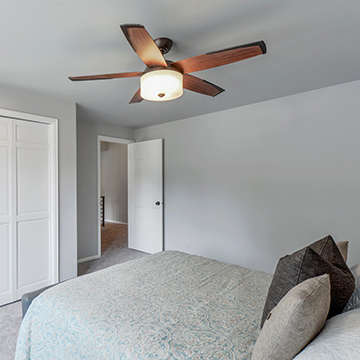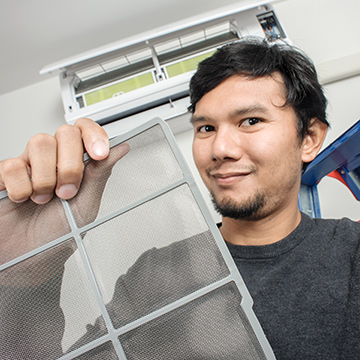Home Cooling
The BED Energy Services team is here to help you understand your energy costs associated with home cooling, and can assist you with reducing the amount of money you pay to stay comfortable during hot weather. Call us at 865-7362 or email us with your natural ventilation and mechanical cooling questions today!
Cool Tips
Before you start shopping for new ACs or fans, have a look at these alternate recommendations for ways to stay cool and save money during warmer months.
- Ovens – Avoid using your oven or stove for long periods of time on hot days.
- Shades – Draw shades and curtains on sunny days. 40% of the unwanted heat that enters your home comes in through windows!
- Shading Devices – Insulated cellular shades keep heat out during the summer and keep heat in during the winter.
- Residential window films reflect sunlight and solar heat gain while reducing glare and still letting some sunlight through.
- Consider installing exterior shading devices like awnings to block summer sun but allow in winter sun.
- Trees – Plant deciduous trees for optimal solar shading in summer. Shading your home can reduce indoor temperatures by up to 20 degrees.
- Exterior Paint – Reflect heat away with light-colored home exterior finishes.
- Radiant Barrier – Install a radiant barrier to reflect heat from the underside of your roof.
- This can reduce heat gains through your ceiling by around 25%.
- Some radiant barriers can also serve as insulation.
- Thermostat Setting – When you’re home, set your thermostat for cooling at 70 – 75F. This is more energy efficient than <70 F. When you’re away, set your thermostat to >75 F to reduce your electric bills.
- You can save 1% in energy bills for every one degree you turn your thermostat up over an eight-hour period. This can add up to very big savings on your energy bill. If you set the thermostat back three degrees all day, every day for a month, you could save 9% on your electricity bill.
- Programmable Thermostats – Never worry about forgetting to turn the air conditioning off. A programmable thermostat always remembers and you’ll notice the savings right away.
- Smart thermostats have additional features like ‘machine learning’ that deduce and update occupants’ schedules and behaviors, and make predictive adjustments to the home’s temperature to optimize comfort.
- Smart thermostats connect to a home’s Wifi network, and allow the home’s temperature to be remotely monitored and adjusted via an app so occupants can make changes on their mobile phone.
- You can receive up to $100 in rebates for smart thermostats.
- Air Conditioner Maintenance – Maintain your air conditioner so it can operate most efficiently.
- Routinely clean air filters; this can reduce energy consumption by 5-15%!
- Annually:
- Clean evaporator coil
- For window AC, inspect and maintain tight seals around window
- For split systems, remove debris and clean outdoor equipment
- Check drain channels for clogs
- Use a fin comb to straighten bent coil fins
- Heat Pump Maintenance – Is your heat pump in clean, working order? The difference between the energy consumption of a well-maintained heat pump and a severely neglected one ranges from 10% to 25%.
- Routinely
- Clean or change air filters once a month or as needed.
- Clean outdoor coils whenever they appear dirty.
- Turn off power to the fan and clean it.
- Annually
- Remove vegetation and clutter from around the outdoor unit.
- Clean supply and return registers as needed.
- Routinely
- Fan Maintenance – Inspect fan blades at the start of the cooling season. If they are caked with dust, they will operate less efficiently. A web search will reveal cleaning strategies for various types of fans.
- Central Air Conditioning – Ensure the ductwork is free of air leaks and is well insulated.
If these steps don’t produce the desired results, keep reading. Or, contact BED Energy Services to schedule an energy audit so we can help you investigate air conditioning issues.
Open Some Windows

Natural ventilation is the practice of bringing fresh, cool air into your home by pushing stale, warm air out of openings like windows. As well as being completely free, natural ventilation is also beneficial for human health. Pollutants are removed from the home as fresh air is brought inside. Natural ventilation is also the most environmentally friendly method of cooling, as it uses much less energy than mechanical cooling (below).
- Natural ventilation is most successful during the coolest parts of the day and at night.
- If your home or apartment has windows that cannot be opened, check if the sashes have been painted shut and free them if you are able.
- Close windows and draw shades during the hottest part of the day.
- Cool your home or apartment in advance of hot summer days by opening windows for ventilation at night.
- Let in cool night air only when humidity is relatively low, as humid air can cause moisture issues.
Natural ventilation as a cooling strategy works best when the temperature inside your home is higher than the outside temperature. In Burlington, this is often possible in late spring and early fall, and during summer nights.
Cross Breezes
To take advantage of a cool daytime breeze, open windows on the side from where the breeze is coming as well as on the opposite side of the house or room. Open interior doors to encourage airflow across the entire floor.
Stack Effect
The stack effect is the principle of airflow moving through a building due to the temperature difference between the inside and outside air, as well as the temperature differences between levels of a building. As warm air rises to upper levels of your home it exhausts out of attic vents, or cracks in the seams of the building. Cool air is sucked into the building at ground level to replace exhausted air.
Use stack effect to your benefit by opening windows on upper floors of your home while also opening windows on the lowest level of your home. If you have skylights in spaces on upper levels of your home, open these during hot days to vent hot air out.
Ventilated attics are around 30 degrees cooler than unventilated attics; louvers help release hot air and prevent moisture build up. If your attic is able to be ventilated, properly size and place your louvers and roof vents. Place intake (soffit) vents low and exhaust (static) vents high.
Run Some Fans
 Air movement makes the human body feel cooler (when the air is below body temperature). Ceiling or portable fans can provide comfort through the process of evaporative cooling. Like the wind chill you might feel when you get out of the pool and the wind carries a breeze, a fan helps you feel cooler by moving air and evaporating water on the surface of your skin.
Air movement makes the human body feel cooler (when the air is below body temperature). Ceiling or portable fans can provide comfort through the process of evaporative cooling. Like the wind chill you might feel when you get out of the pool and the wind carries a breeze, a fan helps you feel cooler by moving air and evaporating water on the surface of your skin.
Fans are most effective during ‘shoulder season’, the weeks of early summer and late fall when your home may feel stuffy and warm. During these times, fresh air will serve as an effective method of cooling.
Learn more about selecting the right fan for your room on the U.S. Department of Energy website.
Ceiling Fans
Ceiling fans are the most effective type of fan at circulating air throughout a room and large blades provide better cooling than small blades. The rotation of the blades on some fans is reversible; in the summer, set fans to rotate counterclockwise so cool air is pulled straight down.
When purchasing a ceiling fan, look for the ENERGY STAR® label; certified fans move air 20% more efficiently. Choose a fan on the ENERGY STAR® Most Efficient 2019 list for products offering the greatest energy efficiency. For other high-performance ceiling fans, check out the full list of ENERGY STAR® certified ceiling fans.
Floor & Window Fans
Energy-efficient, multi-speed and thermostat-controlled fans equipped with timers can make your apartment or home to feel more comfortable on a budget. Floor and window fans with these capabilities can provide great ventilation in a space and enable at the selected speed only when the room gets above the selected temperature and turn off after the selected timeout setting.
Window and floor fans use very little energy and are usually inexpensive.
- Install window fans in windows facing away from the prevailing wind and face them outwards so hot air is exhausted out of your home.
- Use oscillating floor fans to circulate air around larger rooms.
- Open windows on the opposite side of your house to encourage cross breezes.
Did you know that you can operate your window air conditioner in fan-only mode to use it as a window fan? Some air conditioners have auto or econ mode which will automatically switch between fan and cooling mode depending on the temperature outside. Try these quieter and more energy-efficient modes before selecting cooling mode and kicking on the compressor.
Bathroom Exhaust Fans
Bathroom exhaust fans remove hot and moist air from your home, which is especially important in summer. All new homes and residential rentals in Burlington should have bathroom exhaust fans. Call the BED Energy Services team at 865-7362 with your specific questions.
If bathrooms in your home or apartment do not have mechanical ventilation, ensure that in warmer months you open operable windows in your bathroom when taking showers to exhaust humid air outside.
Whole-House Ventilation Systems
Whole-house fans, also called attic fans, are an exhaust ventilation system that can provide whole-building mechanical ventilation by exhausting stale air through the attic and roof and bringing in fresh air through open windows. If designed and operated properly, attic fans can offset some of your air conditioning load at a fraction of the cost of air conditioning. Learn more about designing, installing, and operating whole house fans on the U.S. Department of Energy website.
Whole-house ventilation systems are better suited for larger homes. They provide comprehensive mechanical ventilation to the home via four main strategies: supply, exhaust, balanced, and energy recovery / heat recovery ventilators.
BED Energy Services does not recommend using whole-house fans as the only cooling method for homes in Burlington, as the climate is too humid for whole-house fans to perform throughout the summer to satisfy the entire cooling load of most homes.
Attic fan systems also introduce breaks in the thermal envelope of your home so that in winter, cold air has more openings by which to enter. Unless the fan assembly is well-insulated and air sealed, whole-house fans penetrate the well-sealed boundary of your attic’s insulation layer and can result in increased energy usage during heating season.
Contact our team at 865-7362 to discuss your whole-house fan project to get free technical advice about feasibility and cooling season performance.
Air Conditioning
 Only use air conditioners when you are home. It costs much more money to keep your home cool all day long than it does to set back the temperature or turn it off when you are out.
Only use air conditioners when you are home. It costs much more money to keep your home cool all day long than it does to set back the temperature or turn it off when you are out.
A Word on Humidity
As part of the refrigeration process of reducing the temperature of the air, air conditioners also dehumidify the air a little bit; as the air is cooled, the air conditioner removes some water from the air which lowers its relative humidity. This is why when you remove your window air conditioner for the season, you may have water drip on you. That water is the moisture the air conditioner removed from the air!
Relative humidity (RH) is the amount of water vapor in air expressed as a percentage of the saturation amount for that air temperature. If you have a dehumidifier in your basement to dry it out in warmer months, you are probably familiar with relative humidity, as dehumidifiers are controlled to your selected RH setting.
Room / Window Air Conditioners
The most inexpensive method of air conditioning for homes and apartments are room air conditioners that are installed in a window frame. Window air conditioners use compressors to pump refrigerant between the evaporator and condenser to provide temperature control by cooling the air in your home.
While these can be easy fixes for uncomfortable rooms in your home or apartment, the open window is a source of air leakage and heat gain. Seal window openings with rigid panels and secure with duct tape to reduce energy losses.
If you’re making a purchase today, save money on your bill when you buy a model given the Emerging Technology Award by ENERGY STAR®. A current list of energy efficient Room Air Conditioner models available can be found on the ENERGY STAR website. For a deeper dive, you can use ENERGY STAR’s Room AC calculator spreadsheet to get specific estimated savings for your home when you compare efficient units to a conventional AC unit.
Beware of room AC specials offered by some retailers on the first warm days of spring. While inexpensive room ACs may seem like a good deal at first, the cost to operate one of these appliances over its lifetime should also be considered. When the cost of operation is added to the purchase cost, an ENERGY STAR room AC is the better option.
Central Air Conditioners
For homes with ductwork, central air conditioners can provide cost-effective and energy-efficient cooling than window air conditioners. For homes without ductwork, these systems can be expensive and ductless mini-split heat pumps may be more attractive.
Evaporative Coolers
Evaporative coolers, portable air conditioners, or ‘swamp coolers’ can be an energy-efficient method of mechanical cooling in climates with low humidity. Because they work by evaporating water to bring down the temperature of air by raising its relative humidity, swamp coolers cannot provide effective cooling in humid places like Burlington.
BED Energy Services does not recommend using evaporative ‘swamp’ coolers to provide cooling in Burlington.
Heat Pumps
Heat pumps provide energy-efficient air conditioning (as well as heating) and are more energy-efficient than window and central air conditioners. Ductless, mini-split, air-source heat pumps are neat cooling solutions for homes without ductwork that offer supplemental heating benefits. Ground-source, geothermal heat pumps are the most energy-efficient heat pump solution and have the lowest operating costs.
Call the BED Energy Services team at 865-7362 with your project-specific questions.
- Maintaining Heat Pumps – Is your heat pump in clean, working order? The difference between the energy consumption of a well-maintained heat pump and a severely neglected one ranges from 10% to 25%.
- Routinely
- Clean or change air filters once a month or as needed.
- Clean outdoor coils whenever they appear dirty.
- Turn off power to the fan and clean it.
- Annually
- Remove vegetation and clutter from around the outdoor unit.
- Clean supply and return registers as needed.
- Routinely

